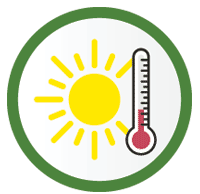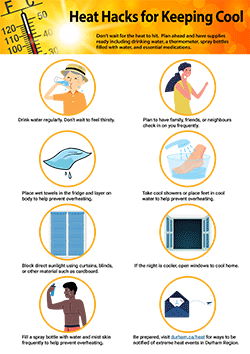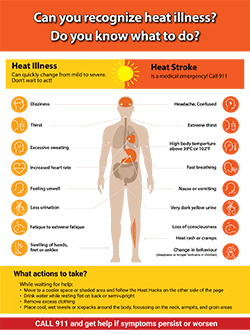
Extreme Heat and Humidity
Current heat statusHeat Warning and Information System (HWIS) The Durham Region HWIS can reduce heat-related illnesses during extreme heat events by alerting the public about extreme heat events, directing community response and outreach to vulnerable and priority populations, and providing individuals with information on how to prevent heat-related illnesses. Community partners: Subscribe to environmental health hazards notifications |

No Heat Warning |
Heat and health
Extreme heat and humidity puts everyone at risk of heat-related illnesses. It is important to protect yourself and your family during extreme heat events.
- Your age and health may make you more susceptible to heat related illness.
- You can become ill while being active during extreme heat. Try to reschedule or plan outdoor activities during cooler parts of the day.
- Remember to frequently call, text or video call and check in with neighbours, friends and older family members, especially those who are chronically ill, to ensure that they are cool and hydrated.
Never leave people or pets inside a parked vehicle on warm days. Anyone seeing a child left unattended in a hot vehicle at anytime should call 911 immediately.
 |
 |
|
Heat illness |
||
|
Symptoms of heat illness:
Common heat illnesses:
Heat strokeHeat stroke is a medical emergency. If you or someone else is having a heat stroke, call 911. Heat stroke symptoms:
While waiting for medical help, you should:
|
||
| How to cool down and when to seek emergency help | ||
If you are feeling any of these symptoms in hot weather, you should:
If the above cooling tips do not make you feel better, seek emergency help or call 911. |
||
| Who is at risk? | ||
You are at greater risk if you:*
*Having multiple risk factors means potentially higher health risks and the need for close monitoring during heat events. |
||
| Protect yourself | ||
Reducing your body temperature during a heat event
Additional precautions
If you must work outside or do physical activity in extreme heat, take extra precautions:
|
||
| Keep your home cool | ||
|
There are ways to keep your home cool even without an air conditioner:
Use your air conditioner. If you are using a window air conditioner, cool the one room you will use for a heat break. If your home is extremely hot:
|
||
| What to do if you do not have air conditioning | ||
|
If you do not have air conditioning, these important steps can help you to keep safe and stay cool during extreme heat:
|
||
|
Local municipal programs and places to help you stay cool |
||
|
Extreme heat resources |
||
|
Brochures
Infographics
Useful links
For schools and child care centres Extreme heat guidance for schools and child care centres For property owners and managers of multi-unit buildings
For health professionals
|
||
|
Community partners Durham Region Health Department gives local municipalities and community partners notification of environmental health hazards such as heat warnings, cold warnings, and poor air quality, as they provide services for those who are more at-risk in our communities. Use the button below to send us an email with "subscribe" in the subject line. Community partners: Subscribe to environmental health hazards notifications Durham Region residents Sign up to receive email updates on this web page to have heat alerts notifications sent directly to your inbox. Sign up to receive email updates
|
||
|
Heat warning levels |
||
The HWIS program notifies community partners and the public about heat warnings and extended heat warnings. Heat warnings (lasts two days) Temperatures are expected to be at least 31°C during the day and overnight temperatures are at least 20°C or Humidex is at least 40. Extended heat warnings (lasts three or more days) Temperatures are expected to be at least 31°C during the day and overnight temperatures are at least 20°C or Humidex is at least 40. |
||
|
Heat warning symbols |
||
|
These images tell you what the current heat warning status is in Durham Region.
Visit Environment and Climate Change Canada's website for more weather information. |
Contact Us





